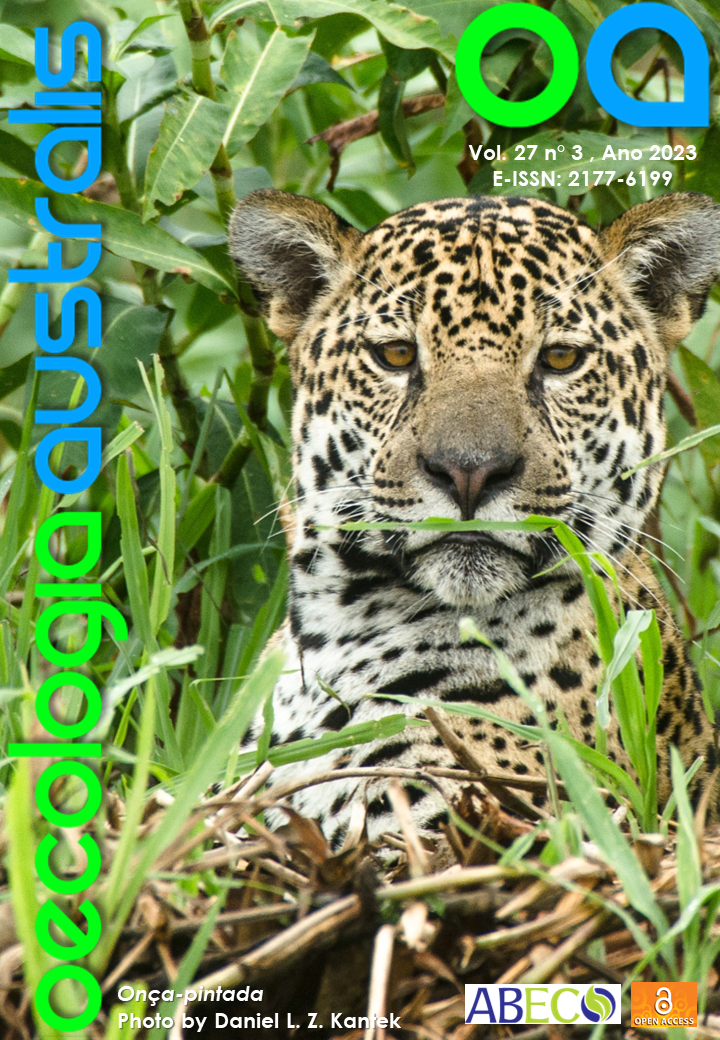AVES MARINHAS NO BRASIL: DESAFIOS PARA A CONSERVAÇÃO
DOI:
https://doi.org/10.4257/oeco.2023.2703.01Keywords:
captura incidental, contaminação, degradação do habitat, espécies exóticas invasoras, Planos de Ação Nacional.Abstract
As aves marinhas compõem 3,5% das aves existentes, com adaptações altamente especializadas para a vida nos oceanos. Aproximadamente um terço dessas espécies ocorre no Brasil, devido à vasta extensão de costa, com 7000 km ao longo de 40° de latitude, além de ilhas costeiras e oceânicas. Apesar de sua longa e peculiar história evolutiva, as aves marinhas estão entre os vertebrados com maior risco de extinção devido às atividades humanas. Nesta síntese, discutimos as principais ameaças e ações para a conservação das aves marinhas no Brasil visando à sensibilização e esclarecimento da sociedade, gestores ambientais e governo. Dentre as ameaças atuais, destacam-se a captura incidental em pescarias, a poluição marinha, a predação por espécies introduzidas, a degradação do habitat e a perturbação humana em colônias e áreas de descanso. Ameaças futuras compreendem atividades humanas emergentes, como a instalação de turbinas eólicas no mar. Para mitigar essas ameaças, diversas ações de conservação têm sido implementadas no âmbito de dois planos de ação nacional, incluindo um específico para os albatrozes e petréis, e outro geral, para as demais aves marinhas ameaçadas. Essas ações incluem o estabelecimento de medidas mitigadoras da captura na pesca, a erradicação de espécies invasoras, o monitoramento de colônias e campanhas de sensibilização. O cenário atual, em geral, é preocupante e necessita ações de órgãos governamentais, incluindo a alocação de recursos e equipes para fiscalização de atividades impactantes e atenção ao licenciamento de empreendimentos no mar. Da sociedade é esperada maior sensibilização quanto aos problemas de conservação das aves marinhas, além de cuidados durante atividades turísticas em áreas de descanso ou próximo às colônias, consumo consciente e descarte apropriado de resíduos.
Seabirds make up 3.5% of the existing birds, with highly specialized adaptations for life in the oceans. In Brazil, with a vast stretch of coast along 40° latitude and 7000 km, in addition to coastal and oceanic islands, approximately one third of the seabird species occur. Despite its long and peculiar evolutionary history, this group is among the vertebrates with highest risk of extinction, due to human activities. In the current synthesis we present threats and actions for seabird conservation in Brazil aiming raise awareness in the society, environmental managers, and government on the topic. Among the current threats are incidental capture in fisheries, marine pollution, predation by introduced species, habitat degradation, and human disturbance in colonies and resting areas. Future threats comprise emerging human activities such as the installation of offshore wind turbines. To mitigate these threats, several conservation actions have been implemented under two national conservation action plans, including one specific to albatrosses and petrels and another general to other threatened seabird species. Conservation actions in Brazil include the establishment of measures to mitigate the capture in fisheries, the eradication of invasive species, monitoring of colonies and awareness campaigns. In general, the current scenario is worrying and requires actions from governmental agencies, such as to allocate resources and teams to inspect activities which are known to impact seabirds, such as fishing, as well as closely monitor the licensing of at sea activities. From the society, it is expected a greater awareness of the problems regarding seabird conservation, as well as care when performing tourist activities in resting areas or near colonies, in addition to conscious consumption and appropriate waste disposal.


